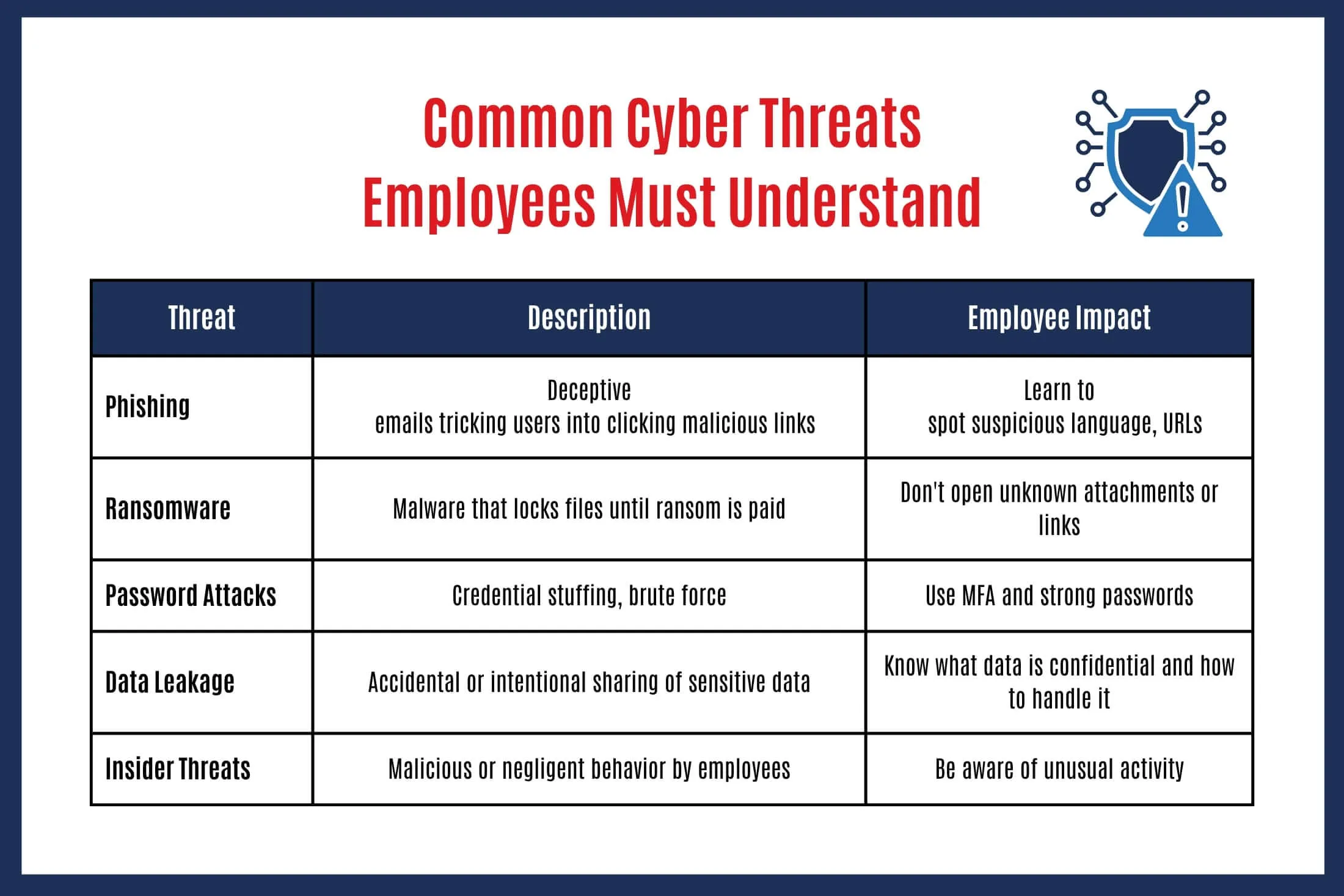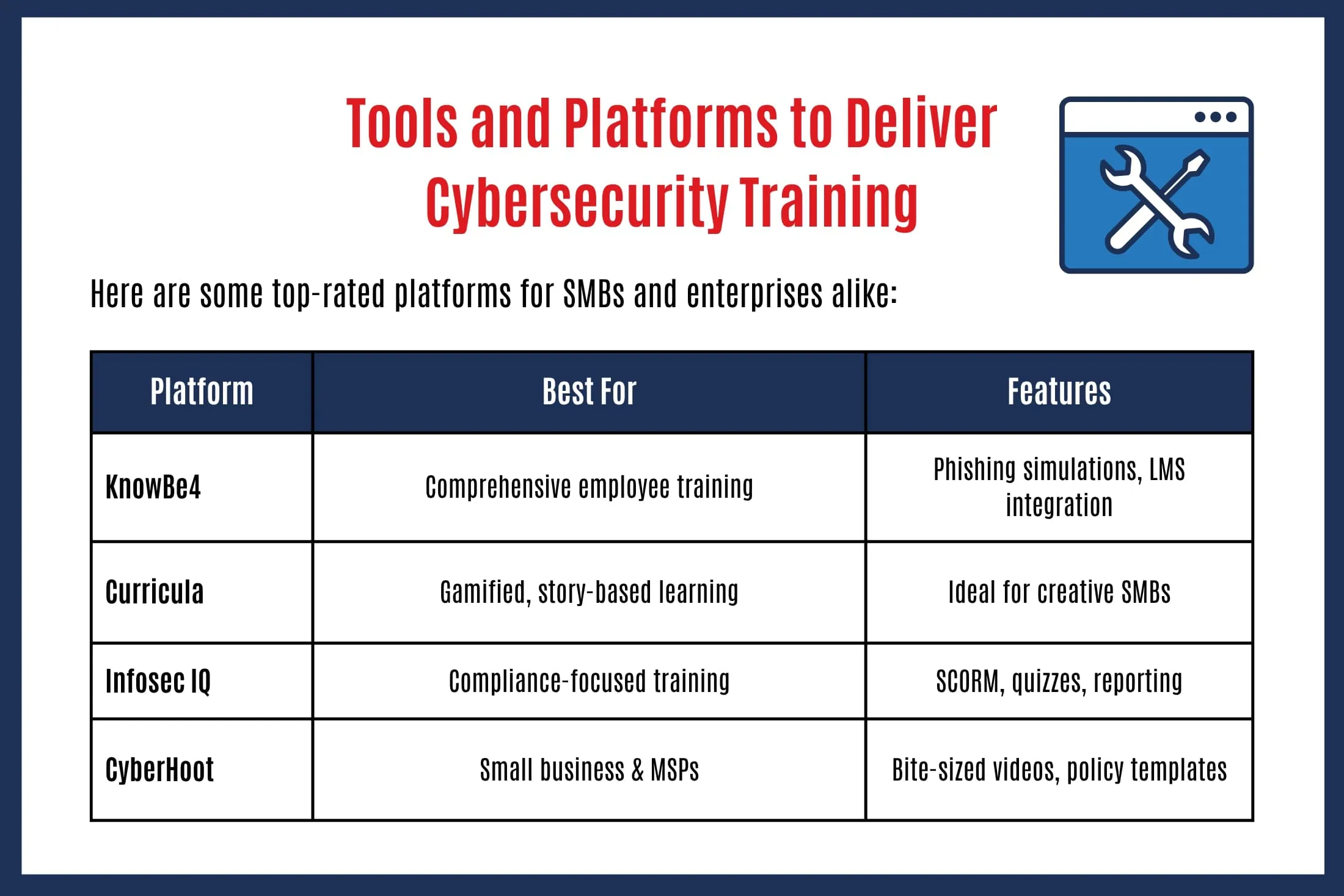Cybersecurity Training for Employees: A Guide for SMBs in New Jersey
Discover why cybersecurity training is essential for employees, especially in SMBs. Learn best practices, tools, and how New Jersey businesses can strengthen their defenses.
Cybersecurity Training for Your Employees: A Complete Guide for SMBs
Human error is the leading cause of cybersecurity breaches. Whether it's clicking on a malicious email, using weak passwords, or mishandling sensitive data, employee actions can expose your organization to serious threats. That’s why cybersecurity training for employees is no longer optional — it's a fundamental layer of your defense strategy.

Why Employee Cybersecurity Training Matters
1. Humans Are the Weakest Link
According to the 2024 Verizon Data Breach Investigations Report, 74% of breaches involve the human element, including errors, privilege misuse, and social engineering.
2. Cyber Threats Are Growing
Threat actors now use AI-powered phishing, business email compromise (BEC), and ransomware-as-a-service to target businesses. Without proper training, your employees are highly vulnerable to these evolving threats.
3. Regulations Require It
Training is often mandated under:
- HIPAA (for healthcare)
- PCI-DSS (for payment processing)
- NIST 800-171 and CMMC (for defense contractors)
- New Jersey’s Data Breach Notification Law
Core Components of an Effective Cybersecurity Training Program

📨 1. Phishing Simulation and Social Engineering Defense
Simulated phishing campaigns help employees recognize suspicious emails and report them. Top tools include:
- KnowBe4
- Cofense
- PhishER
👩💻 2. Role-Based Cybersecurity Awareness
Training should be customized by role:
- Finance teams → Protection against wire fraud
- IT personnel → Advanced topics like patch management, SIEM, and zero trust
- Executives → Business continuity, risk, and compliance
🧩 3. Security Best Practices & Policies
Employees must understand:
- How to create and manage strong passwords (and use password managers)
- What’s acceptable use of corporate devices
- Secure file sharing and remote work practices
🔁 4. Continuous Learning and Microlearning
Instead of annual sessions, adopt:
- Monthly 5–10 minute modules
- Gamified quizzes
- Real-world breach case studies
🧾 5. Testing and Compliance Tracking
Use Learning Management Systems (LMS) or GRC platforms to:
- Track completion
- Automate reminders
- Generate audit-ready reports

Cybersecurity Training for SMBs in New Jersey
Small and medium-sized businesses in New Jersey are especially vulnerable to cyberattacks — but also uniquely positioned to act fast. Here's how SMBs in the Garden State can take practical steps to protect themselves:
1. Leverage State and Federal Resources
- New Jersey Cybersecurity and Communications Integration Cell (NJCCIC) offers free alerts, training material, and incident response resources: https://www.cyber.nj.gov
- NIST Small Business Cybersecurity Corner: Checklists and playbooks for training
- CISA’s Cyber Essentials: Basic training roadmap
2. Address Industry-Specific Compliance
If you're a healthcare provider, legal firm, or fintech startup:
- Review HIPAA or GLBA training requirements
- Include data encryption, secure communication, and breach notification steps
3. Use Local Consultants or MSSPs
Partner with New Jersey-based Managed Security Service Providers (MSSPs) to get:
- Customized training programs
- On-site workshops or virtual sessions
- Ongoing monitoring and policy updates
4. Encourage a Security-First Culture
Create a culture where:
- Reporting phishing is encouraged (not punished)
- Cybersecurity champions are recognized
- Security is seen as everyone’s responsibility, not just IT’s

Building Your Cybersecurity Training Strategy: Step-by-Step
1. Assess Risks and Roles
Map out which employees are exposed to what types of data and systems.
2. Set Objectives
- Reduce phishing click rate
- Increase MFA adoption
- Ensure 100% training completion
3. Choose Your Platform and Content
Customize for your industry, regulatory needs, and user preferences.
4. Launch and Promote the Training
Use internal communications, gamification, or incentives.
5. Measure and Iterate
Use reporting tools to spot weaknesses and update training content regularly.
FAQs
Q1: How often should cybersecurity training be conducted?
At minimum, annually, but ongoing microlearning or monthly refreshers are more effective.
Q2: Is free training enough for SMBs?
Free resources are a good start (especially from NJCCIC or CISA), but for real risk reduction, interactive and simulated training is more effective.
Q3: What if my employees work remotely?
Remote work increases attack surface. Training must cover:
- Secure Wi-Fi usage
- VPNs
- Recognizing social engineering via SMS or personal email
Q4: How can I track compliance for audits?
Use a LMS or GRC platform that tracks completion, quiz scores, and policy acknowledgments.
Q5: What’s the ROI of cybersecurity training?
Companies with strong security culture reduce breach costs by over 50%, according to IBM's 2023 Cost of a Data Breach Report.
Final Thoughts
Cybersecurity training isn’t just an IT task — it’s a strategic investment in your company’s resilience. Whether you're a 100-person logistics company in Newark or a 5-person design studio in Hoboken, your employees are both your greatest risk and your strongest defense.
By making cybersecurity education engaging, ongoing, and customized, you not only reduce your cyber risk — you build trust with clients, partners, and regulators.
✅ Take Action Now
🔒 Don’t wait for a breach to react. Start by:
- Scheduling a phishing simulation
- Assigning 15-minute training this week
- Reviewing your policy documents
📞 Ready to Protect Your Business? Let’s Talk.
At Nexus, we specialize in helping small and medium-sized businesses strengthen their cybersecurity posture with tailored employee training, compliance support, and hands-on protection strategies.
Whether you're just getting started or looking to upgrade your current defenses, our experts are here to help — no jargon, no pressure.
👉 Schedule your FREE cybersecurity consultation today and take the first step toward a safer, more resilient business.
Together, we’ll turn your team into your first line of defense.
Thank you for downloading our guide
Now that you've taken the first step in learning how to transform your business, don't stop there. Contact us today so that together we can take your IT strategy to the next level
Get StartedRelated Posts
Learn why small and mid-sized businesses in the USA need technology advisory services in 2025. Understand the risks, benefits and data-backed reasons to invest in expert IT guidance.
Cloud spending is rising dramatically in 2025, with many businesses seeing their bills double. Discover the reasons behind the spike and how companies are reducing cloud costs by 20–40% using simple optimization strategies.

.webp)







